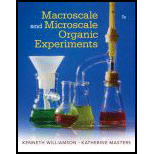
Which experimental method would you recommend for the preparation of 1-bromooctane and of t-butyl bromide?
Interpretation: The experimental method for the preparation of 1-bromooctane and t-butyl bromide needs to be explained.
Concept Introduction: Organic synthesis is a branch of chemical synthesis where the preparation of only organic compounds is studied. Compared to inorganic compounds, organic compounds are more complex. There are several methods for the preparation of an organic compound, but the best experimental method is the one that has fewer steps and gives more yield to the organic compound.
Explanation of Solution
Preparation of 1-bromooctane:
In organic synthesis, 1-bromooctane is an important intermediate. It is soluble in ether and ethanol. It is used for the synthesis of pesticides, surfactants, and organic dyes. There are the following steps involved in the preparation of 1-bromooctane:
- 250 mL of a three-necked flask is taken with a thermostat and stirring machine.
- In the same flask, n-octanol and sulfated zirconia-zincoxide are taken in the desired amount.
- After that hydrobromic acid (40 %) is added slowly to the mixture and it is then stirred well.
- Due to stirring, the temperature of the mixture increases.
- In the next step, a saturated sodium bicarbonate solution is added to the reaction mixture and it is cooled to room temperature.
- The resulting mixture is then separated and washed many times with deionized water until a neutral liquid is obtained.
- The 1-bromooctane produced can be tested by gas chromatography.
Preparation of t-butyl bromide:
The following steps are involved in the preparation of t-butyl bromide:
- In the first step of preparation, 1 mol of tert-butyl alcohol is reacted with 1.25 mol of HBr.
- The obtained mixture is then boiled which results in the distilled volatile tert-butyl bromide.
- The crude tert-butyl bromide obtained in step 2 is shaken with cold sulphuric acid (1/5th volume) in order to dissolve the ether formed as a by-product.
- In the next step, the product is washed with water and sodium bicarbonate to get it free from acid.
- It is washed again with water and dried over calcium chloride.
Want to see more full solutions like this?
Chapter 16 Solutions
Macroscale and Microscale Organic Experiments
- what is the purpose of saturated sodium bicarbonate solution does during the purification of synthesized bromobutane?arrow_forwardObserve the reaction of aromatic aldehyde benzaldehyde with diluted permanganate solution and with fehling's solution. Write the equation for each reaction. How do these results differ from reaction of the given reagents with aliphatic aldehyde?arrow_forwardWhat would be the product of a reaction involving 2-methyl-2-pentene and HBr both with and without the presence of peroxides?arrow_forward
- Explain the purpose of the following steps, write the equation for the rection when applicable. . Using 2,4-dinitrophenylhydrazine and semicarbazide tests to identify aldehydes and ketones.arrow_forwardBriefly explain the electronic effect of the substituent present in p-methoxybenzoic acid as compared to benzoic acid.arrow_forwardSuggest a suitable synthetic strategy for the transformation of 3-methyl-1-pentanol into propyl 3-methylpentanoatearrow_forward
- Write the overall balanced equation and mechanism for the transformation of bromobenzene into benzoic acid through a Grignard reaction. Include all reagents and products but not solvents.arrow_forwardSuggest an experimental procedure by which this protecting group can be removed to regenerate the unprotected diol.arrow_forwardWrite a clear scientific procedure of preparing B-ionone ? What's is the physical properties and safety requirements for each reagent used in the procedure. What's the purification technique that will be used to purify the B-ionone at the end?arrow_forward
- Write Mechanism of sulfonation of benzene and explain the step of reactionarrow_forwardExplain the experimental procedure of the laboratory preparation of the synthesis of Aniline from benzoic acid. (paragraph form) Explain the chemistry behind the synthesis of Aniline from benzoic acid. (paragraph form)arrow_forwardIn a paragraph form provide the experimental procedure of 3-benzoylpropionic acid reaction of Clemmenson, which results in 4-phenyl butanoic acid. Clemmensen reaction is observed in the presence of zinc amalgam and hydrochloric acidarrow_forward
 Macroscale and Microscale Organic ExperimentsChemistryISBN:9781305577190Author:Kenneth L. Williamson, Katherine M. MastersPublisher:Brooks Cole
Macroscale and Microscale Organic ExperimentsChemistryISBN:9781305577190Author:Kenneth L. Williamson, Katherine M. MastersPublisher:Brooks Cole Organic Chemistry: A Guided InquiryChemistryISBN:9780618974122Author:Andrei StraumanisPublisher:Cengage Learning
Organic Chemistry: A Guided InquiryChemistryISBN:9780618974122Author:Andrei StraumanisPublisher:Cengage Learning

